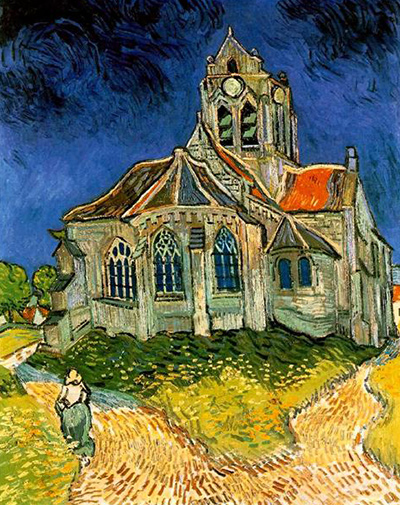The Church at Auvers is a famous oil painting by Vincent van Gogh in June 1890 which is currently displayed in the Musée d'Orsay in Paris, France
Church at Auvers is a classic post-impressionist oil painting by Vincent van Gogh and has become respected as one of his very best. This website is devoted to the original Van Gogh painting and discusses the qualities of the painting as well as the artist's career as a whole. The Church itself is now a major attraction within Auvers thanks to the work of an artist who went onto become much loved right across the world.
The best qualities of the Church of Auvers is the way in which the lighting sets an impressive mood right across the painting, with both darkness and light areas contrasting in different areas of the painting. Van Gogh was always a bold painter and he would happily leave contrasting objects which would immediately grab the attention of the viewer. This boldness is a common theme within the work of notable post-impressionists like Van Gogh.
Van Gogh produced the painting Church at Auvers in 1890 and it can now be found in the Musée d'Orsay, Paris which features an impressive selection of key artworks from the past 500 years and serves as an excellent alternative to the world famous Louvre. For those solely interested in the work of Van Gogh, it is advised to visit his own museum in Amsterdam instead which offers by far the most extensive collection of his work anywhere in the world.
The Church was depicted by the artist in a truly emotional and artistic way, avoiding the typical realist styles that other artists preferred. Van Gogh wanted to instill his own emotion into the building through this painting and did so through a combination of bold colours and shading plus a wavy approach to the objects within the work which left a more interesting look to the building. It was a similar approach to how he handled the sky in Starry Night.
Van Gogh placed a highly aggressive sky scene behind the church and then went for much brighter colours in the foreground and this contrast is similar to what was later found in a Wheatfield with Crows. Artist van Gogh loved to provide the most incredible colours for the main elements of his paintings and would increase the effect of these colours by placing them next to highly contrasting colours from the opposite of his palette.
Doctor Who, a British sci-fi TV series, recently featured the church within one of it's shows, clearly inspired by the work of Van Gogh and the impressive mood which he created within this painting. The particular show also included Vincent Van Gogh as a character in the show and this was just one of many inclusions of him within modern media where his reputation has reached extraordinary levels of respect and popularity.
There are several examples of where Van Gogh would cover buildings in his paintings, but in most cases he would prefer to paint people or landscapes as the integral element. Other examples of Van Gogh buildings included the mental home at which he was housed towards the end of his life and also several locations around Arles where he produced some of his best known paintings such as the Yellow House where he lived with Paul Gauguin and also the Night Cafe.
Church at Auvers is now one of the most loved of all Van Gogh's paintings and many like to buy their own copies of it to add to the walls in their homes or offices, with his fans now spread right across the world. Typically, reproductions of this original come in the form of art prints, posters, stretched canvases and even handmade oil paintings to a lesser frequency.
Whilst being highly innovative and original in his style, Van Gogh used similar techniques across many paintings throughout his career. For example, his portrait of Adeline Ravoux, which came in the same short period which he spent in Auvers-sur-Oise, uses many of the same colours as in Church at Auvers. He was pleased enough with both to discuss them with his brother Theo who would always take the best of his brother's paintings and attempt to sell them in his gallery.
A lesser known work by Van Gogh was The Town Hall at Auvers which he also created around this same time at a point when Vincent had finished developing into the expressive artist that he was to become known best for. Whilst in Saint-Rémy-de-Provence he also painted further scenes covering thatched roof buildings and was always so appreciative of the natural scenes offered to him within the French countryside.
List of Famous Van Gogh Paintings
Please see below for a summarised list of the most popular Van Gogh paintings which are searched for online, right across the world.
- Church at Auvers
- Cyprusses with Wheatfields
- Sunflowers
- Starry Night
- The Potato Eaters
- Almond Branches in Blossom




